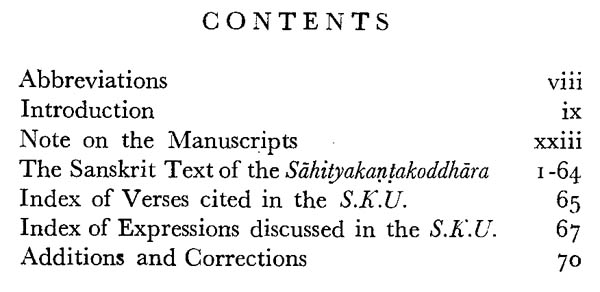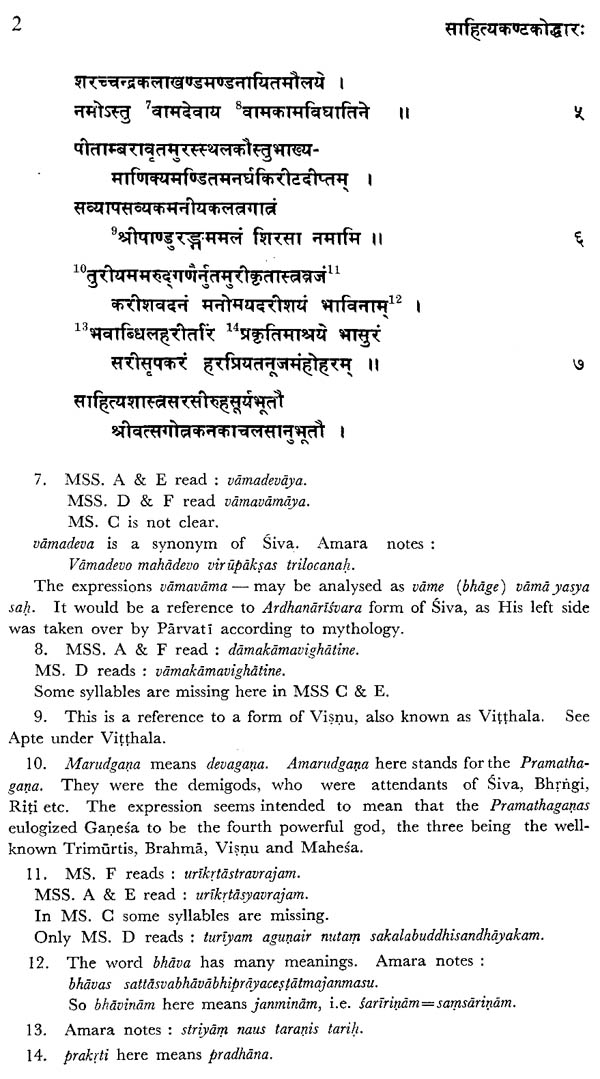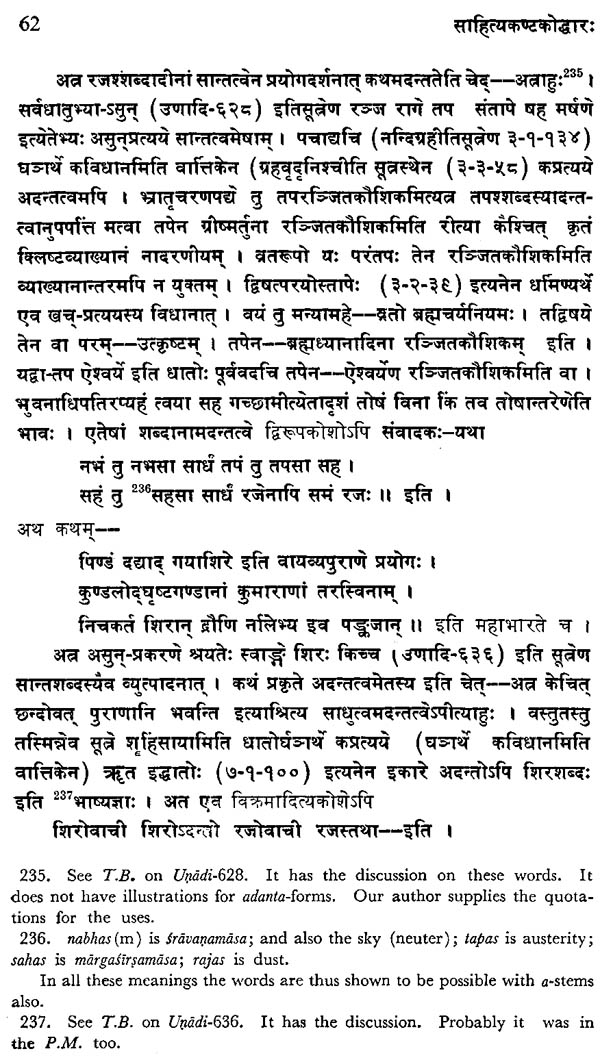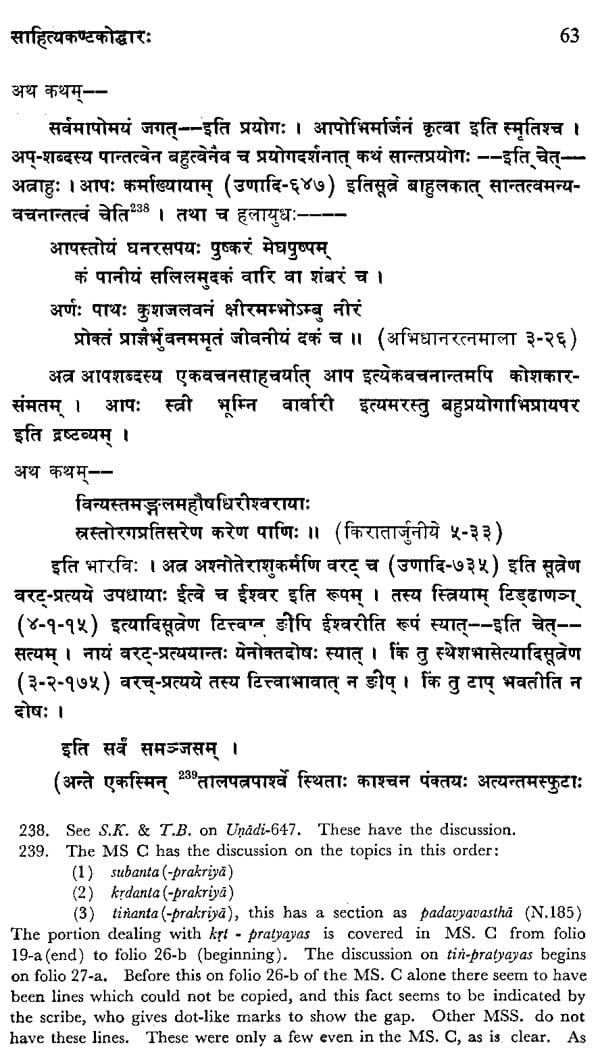
The Sahityakantakoddhara
Book Specification
| Item Code: | NZW746 |
| Author: | T. Venkatacharya |
| Publisher: | MOTILAL BANARSIDASS PUBLISHERS PVT. LTD. |
| Edition: | 1980 |
| ISBN: | 9788120827790 |
| Pages: | 70 |
| Cover: | HARDCOVER |
| Other Details | 9.00 X 6.00 inch |
| Weight | 280 gm |
Book Description
The Sahityakantakoddhara is expository in nature, but belongs to the field of "Grammar as an Applied Science". It is similar to the section on Sabdasuddhi in Kavyalamkdarasitravrtti of Vamana. The 6th chapter in Bhamaha’s Kavya lamkadra, the Prdyogikddhikarana of Vamana, and Durghatavrtti are only a few works that have a systematic treatment pointing out the correctness or otherwise of some of the usages of Poets in Sanskrit. Compared to the bulk of works dealing with other literary aspects, the works on sabdasuddhi are very few. The Sahityakantakoddhara is a new addition in the field. As is made clear by the title, in the opinion of the author of the S.K.U., the incorrect or incorrect-looking usages of Poets are like thorns (i.e. kantaka) on the path of the sahitya. He has tried to clear the path of these thorns. For information about the manuscripts utilised, about the author and his probable date, on new expressions, which are not noted by others in the field — but discussed here, for some new works and authors cited in the S.K.U., and other related topics, see the Introduction and Critical Footnotes.
T. Venkatacharya is a Full Professor in the University of Toronto, where he has been working since 1964. In addition to a number of learned articles published in various research journals both in India and abroad, he has to his credit the following valuable publications:
1. Dasarupaka of Dhananjaya, with Dhanika's Avaloka, and Bhattanrsimha's Laghutika; (Adyar Library Series Volume 97)
2. Sritharicarita-mahakavya: (Adyar Library series 102)
3. The Rasarnavasudhakara of Simhabhupala, with long introduction and copies of notes(Adyar Library series 110)
4. Dasarupaka-Paddhati of Kuravirama;
5. Ubhayabhisarika of Vararuci;
6. Nalakiritikaumudi of Agastyapandita;
7. Krsnacarita of Agastyapandita;
8. The (Gilgit manucript of the) Sanghabhedavastu: (2 parts—jointly with R. Gnoli)
9. The present one: The Sahityakantakoddhara
I. The author of the Sahityakantakoddhara In his History of Classical Sanskrit Literature M. Krishnamachariar mentions on page 789 one Madhusudana as the author of the Sahityakantakodhara (hereafter abbreviated S.K .U.). He does not supply any source or basis for this information about the name of the author. But, I do not find any nanie of the author at all in the manuscripts (7 in all) I have collated for the present edition.
In the verse 9 at the beginning (nityam vaidyaka sastra etc.) the author mentions Narayana as his father. This Narayana is ao described, in the same verse, to have been a dedicated master, who was always bent on explaining clearly the hidden meanings of the texts on the science of medicine (i.e. Ayurveda-Sastra). He is further referred to as Srivat sanvaya-bhisana, i.e. an ornament or a gem in the family belonging to the Srivatsagotra. The mother of the author is described to have been a symbol or a protector of the pativratadharma, and according to some her name is Dharmavati, though the present editor is not convinced about it. Nothing is conveyed about her parents or the family. In verse 8, the author speaks highly about two of his ances tors, mentions them as Koneri Vitthalabudhau and says that they were experts in expounding the science of medicine, who surpassed in the proficiency even the twin divine physicians (ASvinidevas). They, it is stated further, were great scholars in the Sahitya Sastra (i.e. Poetics) and were also like two peaks of the golden mountain of the Srivatsagotra.
Regarding the expression Koneri Vitthalabudhau, the following may be noted. From my namesake and a friend Sri Venkatacharya who is a Senior Sanskrit Pandit in the Government Oriental Manuscripts Library, Madras, [learn that (according to Guruparampara prabhava,? p. 301, line 15—a work in Tamil printed in Telugu script — from which he read out to me) the word Koneru, a Telugu word belonging to the Dravidian family, originally stood for the Svdmipuskarint the pond attached to the Temple on the Tirumala Hills (near Tirupati in Andhra Pradesh) of which the presiding Deity is the Lord Venkatesvara. Lord Venkategvara is regarded as a form of Visnu, is worshipped by many devoted Hindus even now, and is the family Deity of the present Editor also. The word Koneru came subsequently to be used as a name for the place (i.e. Tirumala Hills). Being connected with the sacred place, this expression came to be given as a name to a person by the devotees of Venkategvara. Perhaps the ancestors of our author were devotees of Visnu, as is indicated by the practice. Generally these names are found among the Vaisnavas in South India (e.g. among the followers of Visistadvaita and Dvaita schools, and not found among Advaitins). Koneru or Koneri (a derivative meaning "belonging to Koneru’’) plus Ayya (which came from Arya) results in Konerayya. In the Italian language Venti plus uno becoines ventuno (twentyone). This we may call a parar iipasandhi, i.e. of the two vowels in euphony the second remains, whereas the first is elided. Similarly the expression Konerayya is a case of the Pararipasandhi, which sandhi is common in the Telugu language. Like Italian words, Telugu words also end in Vowels. Professor (in English) is Professore in Italian. Manas and Sras of Sanskrit, for example are Manasu and Sirasu in Telugu. These two similar points, i.e. words ending in Vowels, and the existence of the Pararipasandhi may have been, in addition to other reasons, responsible for the saying that the Telugu is the Italian of the East. Koneri-budha or Konerayya seems similar in significance to Tirumalacarya (the author of the RatnaSana on the Pratdparudriya) or the short form Tiruma layya (from Tirumalarya), which names are common among the people in the Telugu area.
Vitthalacarya, Vitthalarya and Vitthalayya are also known names in South India. Vitthala is the name of a form of Visnu or Krsna worshipped at Pandharpur in Bombay, says Apte in his Dictionary (q.v.).
Thus Koneri-budha (or Konerayya) and Vitthalabudha (or Vitthalac4rya) refer to the two scholars with these names, it seems to me, who were the ancestors and belonged to the Srivatsagotra of which family the author of the S.K.U. was also a descendant, as is made clear in the next verse. In this manner, the names of Koneri-budha, Vitthala-budha and (tatas tu) Narayana are all found in the Introductory verses. But, the name Madhustidana as the name of the author of the S.K.U. is not at all available in the MSS I had access to. It is not clear how and from where M. Krishnamachariar got hold of Madhustdana.
Probably the author chose to remain anonymous, and because of this consideration perhaps even in the colophons no name of the author is found. This is simply my surmise, and till we get some positive evidence it is difficult to have any definite information about the name of the author of the S.K.U.
Our author does not seem to have any sectarian bias against one or the other of the Hindu gods, as seen in the case of some writers of the recent centuries. He pays his obeisance to Sarasvati in verse I, to Visnu in verse 2, to Siva in verses 3, 4, and 5, to Panduranga (i.e. Visnu) in verse 6, and finally to Ganega in verse 7.
Il. The Date of the Author
It is equally difficult to have any definite infor- mation about the date of our anonymous author. Verse 10 of the S.A.U. reads thus :
granthasiksasatam viksya granthikan upaseyya ca,
sahityakantakoddharam nama grantham karomy aham. This reminds us of Devesvara who says in his Kavi- kalpalatad thus :
kavisiksdsatam viksya kavindran upajivya ca, nibaddheyam maya dhiras tvaritaslokasiddhaye.
Not only this. Devesvara says thus also : yad anyair varima na ksunnam tatra samcarato mama, pade pade praskhalatas santas santo avalambanam.
Now let us see what the author of the S.K.U., has. He says (Verse 11) : na ksunno’yam parair margas tatra samcarato mama, pade pade praskhalatas santas santo avalambanam.
In fact, see the very first verse of the S.K.U. which reads thus : Samsaramarusamcedratrsitanam Saririndm, sudhakadambinibhitam tan mahas samupasmahe. Compare this with what Deveévara has in the following :
Samsaramarusamcarasamudbh itaprabh atakhedandm tapatrayatapataptandm asmakam akasmad ajant sudhakadambinikadambasambandhah.
It seems clear from these that our author had received effective inspiration fren Devegvara. S.K.U.
also quotes the line
gaja wa paramahelavilasi
with the words itt Kavikalpalatayam
Deveévara was assigned to the beginning of the 14th century. (See S. K. De’s History of Sanskrit Poetics, p. 260). Our author quotes (see p. 46) a verse from one Narasimhacamp ii, which was perhaps the same as the one attributed to Suryakavi, who wrote the commentary Badlabodhika on the Kavikalpalata. (See S.K. De; Ibid. p. 262). From this we need not take that our author came soon after Devesvara or Siryakavi. He seems to be much later for the following reasons.
In verse 12, he declares namilam likhyate kimeit (which is on the model of Mallinatha). In keeping with this declaration, we notice, all the comments that he makes are made on the authority of many standard works like the Sabdakaustubha of Bhattoji, and the name of Sabdakaustubha is also mentioned in one place (see p. 6). He follows the Praudhamanorama and the Tattvabodhini too, though he does not mention these names. These references are supplied in the Footnotes. See for instance Notes 206, 207, and 220. There are several places where the Sabdakaustubha, the Praudhamanorama, the Siddhanta- kaumudi are utilized by our author. A reference is found to a Kavyaprakasakhandanakara, which does not seem to be to Siddhicandragani, but it may be to Srivatsalafichana-bhattacarya (See Note 32). Srivatsa- lafchana was earlier than Jagennatha who refers to him by name in his Rasagangadhara (p. 39; N.S.P.). Though there is no mention of the Tattvabodhini or Jianendrasarasvati, our author seems to have been either a contemporary or even later than Jmanendra sarasvati. Our author quotes one foot of a verse thus :
prabhus tu vibudhasrayah kati na santi kuksimbharah,
of which the full verse is found in the Tattvabodhint, but no reference to this verse is found in the Sabdakaustubha The quoted part of the verse is attributed by our author to one Dhakkaramakavi. It is not clear as to whether it could be a reference to Gururamakavi of Dindima family. The date of Gururama’s Hariscandracarita is said to be 1607 A.D. See Note 211. The Tattvabodhint which gives the full verse does not mention the name of the author of the verse. The verse which is not found in the Sabdakaustubha, is perhaps not available in the Praudhamanorama too. I have no access to the related yolume of the Praudhamanorama here. Perhaps our author is quoting the verse from the Tativabodhini, and the answer to the problem connected with the usage kuksimbhara in the context is given in the Tattvabodhini, which is referred to by our author by the expression ity eke. There are certain other places too where the S.A.U. seems to be following the Tattvabodhini.
Jiianendrabhiksu (or Jianendrasarasvati) is said to have been a Teacher, in the Vedanta, of the father of Jagannatha, who is assigned to the period between 1590 and 1665 a.p. There is no reference to Jagannatha, as far as I can search, in the S.K.U., and this absence of reference need not mean anything. Jagannatha did not have any systematic discussion about the correctness or otherwise of linguistic uses in literary works, with which our author is mainly concerned here. The absence of any reference, therefore, to Jagannatha need not mean an earlier date for our author. There is no mention of Nagega or his works in the S.A.U. But in one place there is similarity of views of our author and of Nagesa. Our author was probably a contemporary of Nagesa, and belonged to the time by which N&ageéga’s works had not yet travelled to the other parts of the country. Though our author refers to some Paribhdsds (See pp. 51, 52 and 53) there is no reference to the Paribhasendu- sekhara. See also Notes 57, 205. If it was known, I think that the author would have been tempted to make a reference to it by name. The author of the S.K.U., therefore, probably belonged to the latter part of the 17th century or the beginning of the 18th century.
IIl. The title and the subject of the S.K.U.
The S.K.U. does not seem to be intended by the author to serve as a work on Kavistksad (i.e. a manual of instructions to those aspiring to become poets). It is exegetical in nature, but belongs to the field of "Grammar as an Applied Science’. It is similar to the section on sabdasuddhi in the Kavyalamkarastitravrttt of Vamana. The sixth chapter in Bhamaha’s Kavyalamkara, the Prayogikadhtkarana (last sextion) of Vamana, Durghatavrtti, and the anonymous Mukha- bhisana are only a few works that have a systematic treatment pointing out the correctness or otherwise of the usages of the Poets. The Mukhabhisana, which is not known to our author, has a good compilation mostly based on Vamana’s, and sometimes on other authoritative works on grammar, and it has also some new and interesting comments of the anonymous author himself. The 7th chapter of the Advyaprakasa and the S. D., which is based on &. P., have some grammatical discussions on one or two points such as the sandhi, and the use of Parasmaipada or the Atmanepada etc. Compared to the bulk of works dealing with other literary aspects, the (above noted) works on sabdasuddhi are very few. This is what seems to be intended by our author when he Says:
na ksunno’yam parair margah (verse 11).
To the list, which was illustrative and not ex- haustive, of the usages of the Poets noted by previous : writers like Bhamaha, and Vamana, our author has added some more expressions with his own discussions. In keeping with his declaration nam iilam likhyate in verse 12, he has all his discussions corroborated by the authoritative works like the Mahabhasya, Kasika, Nyasa, Padamafjari, Kaiyatapradipa, Sabdakau- stubha etc. He seems to have very high opinion about Bhattoji to whom he refers with the terms as Bhasyarahasyajha, (pp. 8, 24) and Bhasyamanthanakarir.
As is made clear by the title (S.A.U.), in the opinion of our author the incorrect or incorrect looking usages of Poets are like thorns (i.e. kantaka) on the path of the sahitya. He has tried to clear the path of these thorns. Though majority of the uses are collected from the Advyas, there are some expressions culled also from other sources such as the Ramayana, Mahabharata, the Smrti texts, Devimahatmya (This is discussed by Bhattoji and others too) some Madhukosa, works on Vaidyasastra, Fyotissastra and Vayavyapurana (See the Index) etc. It is because of this fact that he seems to have chosen the word Sahitya etc. instead of Kavyakantakoddhara. The word sahitya was understood in the sense of literature in general.
The Introductory verses show that the author was capable of composing some good poetic pieces. See particularly the verse 4 (mirdhni sthitam etc.).
IV. The role played by the present work
The author has accurate knowledge of the con- tents and the context of the verses he has quoted. He has a dependable knowledge of standard works on grammar such as the Mahdbhdsya, the Kasika, Nyasa, Padamanjari, Sabdakaustubha etc. His interpretations and applications of grammatical rules are reliable. He refers to some interesting views about the sandhi and samhita. See Notes 26, 29 and 30, for the details. He is quite familiar with the well-known Mahakavyas. Though some of the expressions he notes were also explained in brief by earlier writers like Vamana, and some commentators on the Mahakavyas, he has his own comments which he conveys by using vayam paryalocayamah etc. (See pp. 20 and 21, 60). He has to his credit also some entirely new expressions which were not noted by other writers. For instance, the following were not noted either by Vamana or the author of the Mukhabhisana (Adyar Publication 1973) :
I. adhimat p.20; Note 84
2. apya p.34; N. 133
3. avis (The position of) p.23; Note 99
4. uditha p.42; N. 162-164
5. kaldstanmayah p.34; N. 134
6. tyajasva p. 43
7. niscotante p.39; N. 153
8. bhavanmaya p. 33-34; N. 132
g. vardhust p. 35; N. 137
10. sdativatam patih p.36; N. 140
11. ntbhdlaya p.45; N. 175
12. hosye p.43; N. 167
Solutions to some of these cases were given by Bhattoji and some other writers on grammar, which are not known and not easily available to many readers. He has collected these from different sources in some cases and presented them in one handy compendium. It is in keeping with his declaration : namilam likhyate kimcit (verse 12). It is a kind of source-book, and in some cases is more than that as the author supplies his own answers.
V. Some names of new works and authors cited in the SAU.
Apart from the well-known works and poets, our author mentions some new names, which are not known —as far as I can search — from other sources.
1. He quotes a part of verse from one Bhrgu vamsa (p. 56).
2. He quotes from one Ramavijaya (p. 68).
3. He refers to one Narasimhacampiikavya (p. 46). This was probably the one attributed to Siryakavi. See S. K. De, H.S.P., p. 262. See also Note 177.
4. He quotes a verse from one Raghiitiamakauya (p. 61), which is attributed to his (elder) brother.
5. There is a reference to one Ldvanyalahari - (p. 50).
6. He quotes the last foot of a verse (prabhus tu etc. p. 54) which is found in full in the Tattvabodhini. See Note 211. This verse is attributed by our author to one Dhakkaramakavi. The name of Dhakka- ramakavi is not found in the Tativabodhini, or in other sources available to me.
7. He refers to one Akbariya-Kalidasa. But the verse cited in the S.K.U. (p. 60) is not found among the verses quoted by Haradatta Sharma in his article (on p. 484) in the Indian Historical Quarterly (v. X; 1934, September). But there is also some confusion because of the use of Kavikalpalatayam here. See Note 231-a.
VI. The following is the list of works and authors mentioned in the S.A.U.
1. Akbariya-Kalidasa page 60
2. Anekdrthasamgraha p. 9
3. Abhinanda p. 59
4. Amara pp. 8, 9, 18, 22, 35, 57, 59
5. Udararaghava pp. 16, 20, 53
6. Kavikalpalata p. 60
7. Kaviraja p. 35
8. Kalidasa pp. 14, 17, 22, 24, 31, 32, 35, 36,
9. Kavyakanthabharana p. 38
10. Kédvyaprakasa pp. 5, 48
11. Kavyaprakasakhandanakara p. 5
12. Rasika p. 25
13. Kicakavadha p.22
14. Krsnamisra p. 36
15. Kaiyata p. 21
16. Kaiyata-haradattadi p. 8
17. Gitagovinda p. 12
18. Cdndrasitra p. 18
19. Caurapancasat p. 5
20. fyolissdstra p. 27
21. Dhakkaramakavi p. 55
22. Trikdndasesa p. 22
23. Durghata Vriti p. 21
24. Devimahatmya p. 47
25. Dviripakosa pp. 22, 59, 60, 62
26. Namalinganusdsana p. 8
27. WNitisastra p. 6
28. Naisadha pp. 8, 14
29. Nyadsakara-haradattau p. 13
30. ParaSara p. 13
31. Parijataharana (camp) p. 60
32. Puspadanta p. 25
33. Prataparudriyakéra p. 39
34. Bilhana pp. 5, 32, 37, 41
35. Bhatti pp. 25, 55, 57, 58
36. Bhavabhiti p. 36
37. Bhaga Vrtti p. 49
38. Bhaguri p. 44
39. Bharata p. 13
40. Bharavi pp. 15, 19, 26, 27, 31, 37, 58, 63
41. Bhasa Vritt p. 37
42. Bhasyakara p. 24
43. Bhdasyajfia p. 36
44. Bhdasyamanthanakartr p. 29
45. Bhasyarahasyajia pp. 8, 12
46. Bhrguvamsa p. 56
47. Bhratrcarana (elder brother of the author) p. 61
48. Madhukosa p. 34
49. Mammata p. 34
50. Mayira p. 58
51. Mahabharata pp. 18, 62
52. Magha pp. 11, 17, 19, 23, 24, 25, 28, 41,45, 50
53. Munitraya p. 8
54. Murari pp. 30, 50, 54, 56, 58
55. Raghuvamsa pp. 9, 19
56. Rabhasakosa p. 22
57. Raghavapandaviya p. 60
58. Ramavyaya p. 58
59. Ramdyana pp. 13, 18
60. Rayamakuta p. 61
61. Ldvanyalaharit p. 50
62. Varnaviveka p. 58
63. Vagbhata p. 27
64. Vdyavyapurana p. 62
65. Vasavadatta p. 44
66. Vikramadityakosa p. 62
67. Vikramorvasiya p. 14
68. Vritikdra pp. 23, 45
69. Vaidyasastra p. 61
70. Sabdakaustubha p. 6
71. Sakalyamalla pp. 16, 20, 43
79. Sridharasvamin p. 36
73. Sriharsa pp. 8, 18
74. Samsdardvarta p. 59
75. Sarasvatikanthabharana p. 12
76. Saundaryalahari p. 57
77. Smrit p. 13
78. Haradatta pp. 23, 35
79. Halayudha p. 63
80. Hemacandra p. 8
**Contents and Sample Pages**










